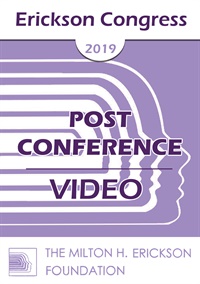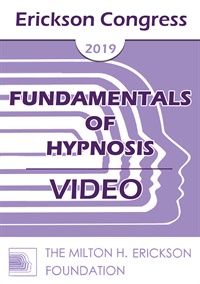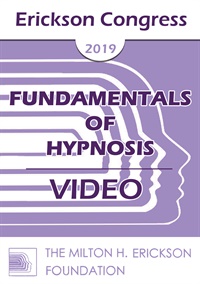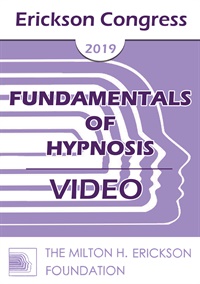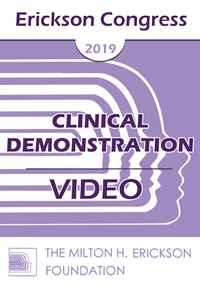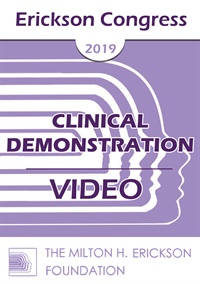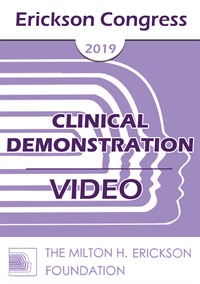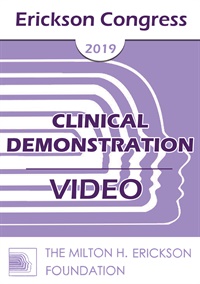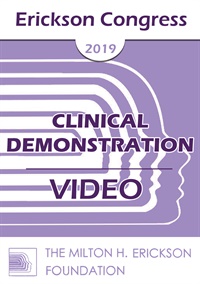- Average Rating:
- Not yet rated
- Topic Areas:
- Master Classes | Ericksonian Psychotherapy | Psychotherapy | Brief Therapy | Hypnotherapy | Self-Relations | Utilization
- Categories:
- Erickson Congress | Erickson Congress 2019
- Faculty:
- Bill O'Hanlon, MS | Jeffrey Zeig, PhD
- Course Levels:
- Master Degree or Higher in Health-Related Field
- Duration:
- 4 Hours 49 Minutes
- Format:
- Audio and Video
- Original Program Date:
- Dec 16, 2019
- Short Description:
- Ericksonian hypnotherapy and the Self-Relations approach are experiential methods of change. In combination they can be synergistic. Psychotherapy is best when clients have a first-hand experience of an alive therapeutic process. Such dynamic empowering experiences pave the way for dynamic understandings. Bill O’Hanlon and Jeffrey Zeig will engage with each other and the participants to examine commonalities and differences in their work.
- Price:
- $59.00 - Base Price
- Average Rating:
- Not yet rated
- Topic Areas:
- Fundamentals of Hypnosis | Hypnosis | Hypnotic Phenomena | Hypnotherapy | Ericksonian Hypnosis and Therapy Techniques
- Categories:
- Erickson Congress | Erickson Congress 2019
- Faculty:
- Dan Short, PhD
- Course Levels:
- Master Degree or Higher in Health-Related Field
- Duration:
- 2 Hours 1 Minutes
- Format:
- Audio and Video
- Original Program Date:
- Dec 15, 2019
- Short Description:
- Erickson resisted standardized hypnotic protocols because he found that everyone responded to hypnosis uniquely. Rather than seeking to force his preferred hypnotic phenomena, he cultivated whatever came naturally. Fortunately, clinical objectives, such as pain relief, can be achieved using a variety of hypnotic phenomena. This session will identify three broad classes of hypnotic experiencing and provide guidance on how to identify natural predispositions.
- Price:
-
Sale is $29.00
price reduced from Base Price - $59.00
- Average Rating:
- Not yet rated
- Topic Areas:
- Fundamentals of Hypnosis | Dissociation | Ericksonian Hypnosis and Therapy Techniques
- Categories:
- Erickson Congress | Erickson Congress 2019
- Faculty:
- Michael Yapko, PhD
- Course Levels:
- Master Degree or Higher in Health-Related Field
- Duration:
- 1 Hour 15 Minutes
- Format:
- Audio and Video
- Original Program Date:
- Dec 15, 2019
- Short Description:
- This advanced training examines dissociation and automaticity as the defining features of hypnosis and their value in clinical work. Participants learn how attention, suggestion, and post-hypnotic processes create non-volitional change and how these mechanisms can be applied for pain control, anxiety reduction, and behavioral flexibility. Blending neuroscience, demonstration, and practical exercises, the session shows how dissociation and sensory alteration can transform symptom patterns into opportunities for self-regulation and healing.
- Price:
-
Sale is $29.00
price reduced from Base Price - $59.00
- Average Rating:
- Not yet rated
- Topic Areas:
- Fundamentals of Hypnosis | Trance | Hypnosis | Art and Creativity | Communication
- Categories:
- Erickson Congress | Erickson Congress 2019
- Faculty:
- Stephen Gilligan, PhD
- Course Levels:
- Master Degree or Higher in Health-Related Field
- Duration:
- 1 Hour 51 Minutes
- Format:
- Audio and Video
- Original Program Date:
- Dec 15, 2019
- Short Description:
- In therapeutic trance, a person releases from rigid ego positions, thereby opening to the resources and healing capacities of the creative unconscious. In this process, nonverbal communications—such as limbic resonance, felt sense, somatic centering, and musicality—are of central importance. The workshop explores how therapists may attune to these nonverbal patterns and utilize them to develop and guide creative trance work.
- Price:
-
Sale is $29.00
price reduced from Base Price - $59.00
- Average Rating:
- Not yet rated
- Topic Areas:
- Clinical Demonstrations | Hypnosis | Resources
- Categories:
- Erickson Congress | Erickson Congress 2019
- Faculty:
- Jeffrey Zeig, PhD
- Course Levels:
- Master Degree or Higher in Health-Related Field
- Duration:
- 58 Minutes
- Format:
- Audio and Video
- Original Program Date:
- Dec 15, 2019
- Short Description:
- Clients progress by the realizations they achieve in treatment. Evocative methods prompt conceptual realizations that prompt adaptive states and identities. Experiential methods derived from hypnosis can be applied with and without formal trance.
- Price:
-
Sale is $29.00
price reduced from Base Price - $59.00
IC19 Clinical Demonstration 03 - Guided Imagery and Brief Therapy Using Hypnosis - Rubin Battino, MS
- Average Rating:
- Not yet rated
- Topic Areas:
- Clinical Demonstrations | Brief Therapy | Hypnosis | Meditation, Spirituality and Yoga
- Categories:
- Erickson Congress | Erickson Congress 2019
- Faculty:
- Rubin Battino, MS
- Course Levels:
- Master Degree or Higher in Health-Related Field
- Duration:
- 57 Minutes
- Format:
- Audio and Video
- Original Program Date:
- Dec 15, 2019
- Short Description:
- The use of guided imagery using hypnosis will be demonstrated with a volunteer as a method of doing brief therapy. The volunteer may present a physical or behavioral difficulty for this demonstration. Also demonstrated will be the use of physical anchors.
- Price:
-
Sale is $29.00
price reduced from Base Price - $59.00
- Average Rating:
- Not yet rated
- Topic Areas:
- Clinical Demonstrations | Trance | Generative Psychotherapy
- Categories:
- Erickson Congress | Erickson Congress 2019
- Faculty:
- Stephen Gilligan, PhD
- Course Levels:
- Master Degree or Higher in Health-Related Field
- Duration:
- 1 Hour 3 Minutes
- Format:
- Audio and Video
- Original Program Date:
- Dec 15, 2019
- Short Description:
- This clinical demonstration will explore how the skillful use of therapeutic trance can produce positive change. A six step model will be demonstrated: (1) Opening a positive connection, (2) goal setting, (3) cultivating a relational trance field, (4) including client parts into field, (5) transforming identify patterns, (6) bringing changes into real world.
- Price:
-
Sale is $29.00
price reduced from Base Price - $59.00
- Average Rating:
- Not yet rated
- Topic Areas:
- Clinical Demonstrations | Mind-Body | Pain and Healing | Yes Set
- Categories:
- Erickson Congress | Erickson Congress 2019
- Faculty:
- Jeffrey Feldman, PhD
- Course Levels:
- Master Degree or Higher in Health-Related Field
- Duration:
- 58 Minutes
- Format:
- Audio and Video
- Original Program Date:
- Dec 15, 2019
- Short Description:
- Individuals are often referred for mind-body oriented pain management services concerned that the referring physician thinks that their pain is not real or that it is “all in my head”. The way in which such concerns are addressed and the relationship between mind and body is explained to patients will be demonstrated.
- Price:
-
Sale is $29.00
price reduced from Base Price - $59.00
Tags: Mind-Body Pain & Healing Yes Set
- Average Rating:
- Not yet rated
- Topic Areas:
- Clinical Demonstrations | Hypnosis | Hypnotic Induction | Language of Hypnosis | Trance
- Categories:
- Erickson Congress | Erickson Congress 2019
- Faculty:
- Norma Barretta, PhD | Jolie Barretta
- Course Levels:
- Master Degree or Higher in Health-Related Field
- Duration:
- 59 Minutes
- Format:
- Audio and Video
- Original Program Date:
- Dec 15, 2019
- Short Description:
- Using a conversational trance induction and developing a deeper level of self-differentiation and autonomy with confidence building.
- Price:
-
Sale is $29.00
price reduced from Base Price - $59.00
- Average Rating:
- Not yet rated
- Topic Areas:
- Keynotes | Hypnosis | Ericksonian Hypnosis and Therapy Techniques | Evocative Communication
- Categories:
- Erickson Congress | Erickson Congress 2019
- Faculty:
- Bill O'Hanlon, MS
- Course Levels:
- Master Degree or Higher in Health-Related Field
- Duration:
- 56 Minutes
- Format:
- Audio and Video
- Original Program Date:
- Dec 15, 2019
- Short Description:
- In this provocative session, Bill O'Hanlon will make the case that Ericksonian Hypnosis does not involve suggestion but instead involves evocation of already existing resources, and that Ericksonian Therapy involves a radical departure from the usual diagnostic, pathological-oriented approach that strives to fix or correct the client’s or patient’s deficits and brokenness.
- Price:
- $29.00 - Base Price
- Average Rating:
- Not yet rated
- Topic Areas:
- Clinical Demonstrations | Utilization | Dissociation | Hypnosis
- Categories:
- Erickson Congress | Erickson Congress 2019
- Faculty:
- Brent Geary, PhD
- Course Levels:
- Master Degree or Higher in Health-Related Field
- Duration:
- 58 Minutes
- Format:
- Audio and Video
- Original Program Date:
- Dec 15, 2019
- Short Description:
- Dissociation is a critical element in hypnosis. But its converse, association, is highly useful in generating individualized hypnotic therapy. This demonstration will illustrate the importance of utilizing associations of both the subject and the hypnotist.
- Price:
-
Sale is $29.00
price reduced from Base Price - $59.00
Tags: Dissociation Hypnosis Utilization
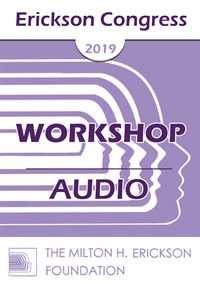
- Average Rating:
- Not yet rated
- Topic Areas:
- Workshops | Mind-Body | Trauma | Hypnosis | Healing | Resilience
- Categories:
- Erickson Congress | Erickson Congress 2019
- Faculty:
- Ronald Alexander, PhD
- Duration:
- 2 Hours
- Format:
- Audio Only
- Original Program Date:
- Dec 15, 2019
- Short Description:
- This workshop blends Ericksonian hypnosis, somatic experiencing and mindfulness to help clients move from traumatic overwhelm into regulated, resilient states. Participants learn practical tools like witnessing awareness, pendulation, grounding, breathwork, and gentle movement to calm the nervous system and reopen access to choice. Through demonstrations, stories and guided practices, the session shows how mind-body approaches can dissolve freeze states, release constriction, build internal resources and support lasting trauma recovery.
- Price:
- $15.00 - Base Price
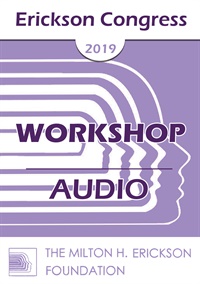
- Average Rating:
- Not yet rated
- Topic Areas:
- Workshops | Meditation, Spirituality and Yoga | Mindfulness
- Categories:
- Erickson Congress | Erickson Congress 2019
- Faculty:
- Connirae Andreas, PhD
- Duration:
- 1 Hour 52 Minutes
- Format:
- Audio Only
- Original Program Date:
- Dec 15, 2019
- Short Description:
- Through guided experiential work, this workshop invites participants into a direct exploration of awareness, identity, and inner organization. Using simple yet precise inquiries, it demonstrates how emotional suffering, reactivity, and stress can soften when core patterns of self are gently integrated, offering a lived sense of ease, presence, and psychological wholeness.
- Price:
- $15.00 - Base Price
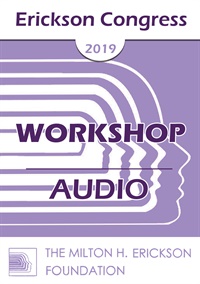
- Average Rating:
- Not yet rated
- Topic Areas:
- Workshops | Trauma | Therapeutic Relationship | Therapist Development
- Categories:
- Erickson Congress | Erickson Congress 2019
- Faculty:
- John Beahrs, MD
- Duration:
- 1 Hour 59 Minutes
- Format:
- Audio Only
- Original Program Date:
- Dec 15, 2019
- Short Description:
- Ratifying victimhood often paradoxically sensitizes to trauma’s effects, and is heavily reinforced socially. Therapists are challenged to help victims restore personal agency and accountability, without denying victimhood. Contracting for roles and boundaries precedes efforts to interdict traumatic re-enactment, redefine personal and social identity, access locus of control, and restore accountability.
- Price:
- $15.00 - Base Price
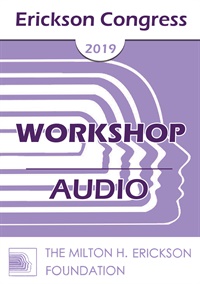
- Average Rating:
- Not yet rated
- Topic Areas:
- Workshops | Anxiety | Cognitive Behavior Therapy (CBT) | Hypnosis | Mindfulness | Worry
- Categories:
- Erickson Congress | Erickson Congress 2019
- Faculty:
- Carolyn Daitch, PhD
- Duration:
- 2 Hours 2 Minutes
- Format:
- Audio Only
- Original Program Date:
- Dec 15, 2019
- Short Description:
- Anxiety destroys the normal enjoyment of life through the fear, worry, obsessive thinking and avoidant behavior that anxious people experience. Simple activities like going to the grocery store, taking a child to her first day of school, or meeting a friend for lunch trigger a barrage of frantic “what ifs.” This demonstration will explore the subtleties of working with this pervasive category of disorders, and will introduce a powerful, integrative therapy model.
- Price:
- $15.00 - Base Price
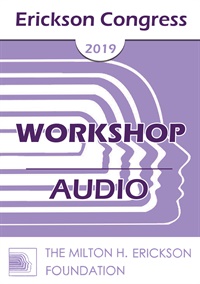
- Average Rating:
- Not yet rated
- Topic Areas:
- Workshops | Art and Creativity | Hypnosis | Hypnotherapy | Music
- Categories:
- Erickson Congress | Erickson Congress 2019
- Faculty:
- Norma Barretta, PhD | Jolie Barretta
- Duration:
- 1 Hour 55 Minutes
- Format:
- Audio Only
- Original Program Date:
- Dec 15, 2019
- Short Description:
- Hypnosis can interrupt dysfunctional loops, breaking negative patterns. With the skillful addition of sound that process is often speeded up and has a profound effect physiologically as well as psychologically, influencing and entraining the biological state of the subject. Participants will be shown how to enhance their awareness of tonality, volume, and the power inherent in vowel sounds. Using frequencies to deepen trance will be part of the group experience.
- Price:
- $15.00 - Base Price
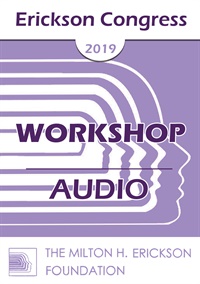
- Average Rating:
- Not yet rated
- Topic Areas:
- Workshops | Trance | Hypnotherapy | Unconscious Processes
- Categories:
- Erickson Congress | Erickson Congress 2019
- Faculty:
- Stephen Gilligan, PhD
- Duration:
- 2 Hours 1 Minutes
- Format:
- Audio Only
- Original Program Date:
- Dec 15, 2019
- Short Description:
- This workshop presents Dr. Gilligan’s latest work of Systemic Trance, which describes how we generate our realities via the (mostly unconscious) maps of who we are, and what the world is. These systemic filters can be held negatively (in neuro-muscular lock) or generatively (in creative flow), resulting in either problems or positive solutions. To transform problems into resources, Systemic Trance first identifies the key parts of a performance map, then uses generative trance to open a fluid conversational space where each part is positive valued and integrated into a resource pattern. Lecture, demonstration, case examples, and exercises will be included.
- Price:
- $15.00 - Base Price
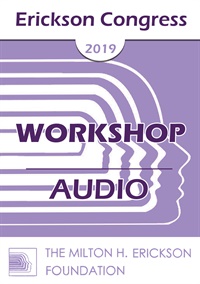
- Average Rating:
- Not yet rated
- Topic Areas:
- Workshops | LGBTQ | Multicultural | Strengths-Based | Ericksonian Hypnosis and Therapy Techniques
- Categories:
- Erickson Congress | Erickson Congress 2019
- Faculty:
- Rick Miller, MSW
- Duration:
- 1 Hour 51 Minutes
- Format:
- Audio Only
- Original Program Date:
- Dec 15, 2019
- Short Description:
- The emotional mystique between gay sons and their mothers has long been unexplored, but now new evidence suggests that a mother’s response to her son’s sexuality isn’t the only factor in his future success. How she nurtures him based on his interests, rather than his sexual preferences, is key, especially in a society with narrow definitions of masculinity.
- Price:
- $15.00 - Base Price

- Average Rating:
- Not yet rated
- Topic Areas:
- Workshops | Eating Disorders | Ericksonian Hypnosis and Therapy Techniques | Addiction | Hypnosis
- Categories:
- Erickson Congress | Erickson Congress 2019
- Faculty:
- Albina Tamalonis, PsyD
- Duration:
- 1 Hour 57 Minutes
- Format:
- Audio Only
- Original Program Date:
- Dec 15, 2019
- Short Description:
- During the first hour of this workshop the specific treatment ideas targeting Eating Disorders will be presented. Also, the workshop will delineate how an eating disorder is an addiction and present the underlying issues, which need to be addressed because of an addiction’s multi-dimensional infiltration. The remaining hour will be a demonstration of Ericksonian Hypnosis on a volunteer who wants to lose or gain any amount of weight. You will see: a Ericksonian diagnostic interview which focuses on the present where the solutions can be found; an Ericksonian induction using conscious/unconscious dissociation; a Ericksonian suggestion phase tailored to fit the patient; and a reorientation out of trance. There will be some time for questions and discussion.
- Price:
- $15.00 - Base Price
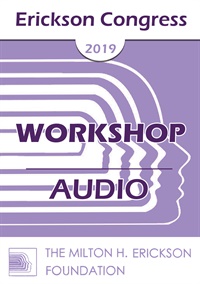
- Average Rating:
- Not yet rated
- Topic Areas:
- Workshops | Trauma | Experiential Therapy | Polyvagal Theory
- Categories:
- Erickson Congress | Erickson Congress 2019
- Faculty:
- Maggie Phillips, PhD
- Duration:
- 1 Hour 57 Minutes
- Format:
- Audio Only
- Original Program Date:
- Dec 15, 2019
- Short Description:
- This workshop presents a 3-Step Model for creating effective corrective experiences for traumatized clients. These steps are Hypnosomatic Resourcing, Re-regulating Nervous System Responses to Post-traumatic Triggering, and Repairing and Rewiring through Enduring Self-integration and Secure Attachment with Self and Others for Permanent Change. We will explore how to help clients shift from more passive responses in their lives to the use of action systems.
- Price:
- $15.00 - Base Price
Tags: Experiential Polyvagal Trauma
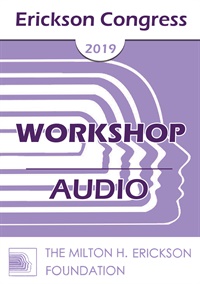
- Average Rating:
- Not yet rated
- Topic Areas:
- Workshops | Grief | Ericksonian Hypnosis and Therapy Techniques | Ericksonian Psychotherapy | Hypnosis | Psychotherapy | Aging and Mortality
- Categories:
- Erickson Congress | Erickson Congress 2019
- Faculty:
- Teresa Garcia-Sanchez, MA
- Duration:
- 1 hour 46 minutes
- Format:
- Audio Only
- Original Program Date:
- Dec 15, 2019
- Short Description:
- Loved ones leave us, couples and friends separate, we suffer physical changes as we grow up during adolescence and as we grow old, work changes happen, as well as our mood, which evolves throughout our lives.
- Price:
- $15.00 - Base Price
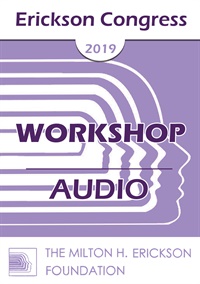
- Average Rating:
- Not yet rated
- Topic Areas:
- Workshops | Multicultural | Strategic Therapy | Strengths-Based
- Categories:
- Erickson Congress | Erickson Congress 2019
- Faculty:
- Terry Soo-Hoo, PhD
- Duration:
- 2 Hours 3 Minutes
- Format:
- Audio Only
- Original Program Date:
- Dec 15, 2019
- Short Description:
- Much of this Workshop will address issues of culture, race, sexual orientation, diversity and social justice and equality, etc. A major premise is the idea that all therapy is multicultural therapy. This means that every client brings to therapy a unique world and therefore the challenge for every therapy is for the therapist to be able to enter the unique world of each client. This therapy method is especially adept at working with cultural differences as it is highly adaptable and therefore able to work within the unique world of the client.
- Price:
- $15.00 - Base Price
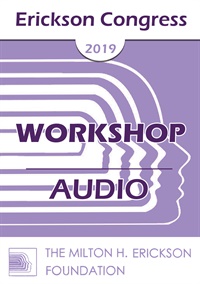
- Average Rating:
- Not yet rated
- Topic Areas:
- Workshops | Obsessive Compulsive Disorder (OCD) | Hypnosis | Post-Hypnotic Suggestion | Suggestion
- Categories:
- Erickson Congress | Erickson Congress 2019
- Faculty:
- Krzysztof Klajs, Dipl. Psych
- Duration:
- 1 Hour 57 Minutes
- Format:
- Audio Only
- Original Program Date:
- Dec 15, 2019
- Short Description:
- OCD is a rather chronic illness affecting about 2.5% of adults. Its diagnosis is perceived as a demanding and challenging one. Trance phenomena can be described as natural behavioral manifestations of the trance state. They can be observed in individuals as well as in family communication patterns. In OCD families, one of the most powerful and widely present trance phenomena are the posthypnotic suggestions. They are invisible, deeply hidden, mighty and long lasting.
- Price:
- $15.00 - Base Price
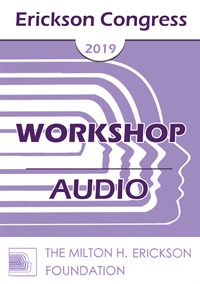
- Average Rating:
- Not yet rated
- Topic Areas:
- Workshops | Naturalistic | Ericksonian Hypnosis and Therapy Techniques | Utilization
- Categories:
- Erickson Congress | Erickson Congress 2019
- Faculty:
- Helen Erickson, PhD, MSN, AHN-BC, FAAN, SGAHN
- Duration:
- 1 Hour 57 Minutes
- Format:
- Audio Only
- Original Program Date:
- Dec 15, 2019
- Short Description:
- People have holistic, mind-body-brain interactions, an inherent predisposition to grow, individuate and actualize their potential. But sometimes people get stuck due to their concurrent need for human affiliations. A sense of unresolved loss between the two effects their ability to develop a healthy balance of affiliated-individuation which is needed to negotiate the multiple epigenetic developmental tasks from birth to death.
- Price:
- $15.00 - Base Price
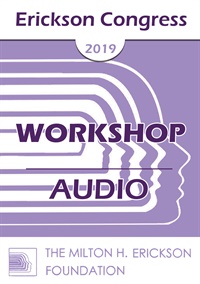
- Average Rating:
- Not yet rated
- Topic Areas:
- Workshops | Neuroscience | Unconscious Processes | Consciousness | Mindfulness | Trance
- Categories:
- Erickson Congress | Erickson Congress 2019
- Faculty:
- Richard Landis, PhD | Gary Ruelas, DO, PhD
- Duration:
- 1 Hour 58 Minutes
- Format:
- Audio Only
- Original Program Date:
- Dec 15, 2019
- Short Description:
- Whether it is a deep state of trance, a phenomenon of awe-ness, a psychedelic induced expansion, and/or a break through or breakdown of perception, therein lays a greater and “deeper” experience of change. From a neuroplastic or biological state there is the activation of the midbrain, such as the amygdale, cingulate gyrus, nucleus accumbens, which then alter the perceptions of the neocortex.
- Price:
- $15.00 - Base Price


